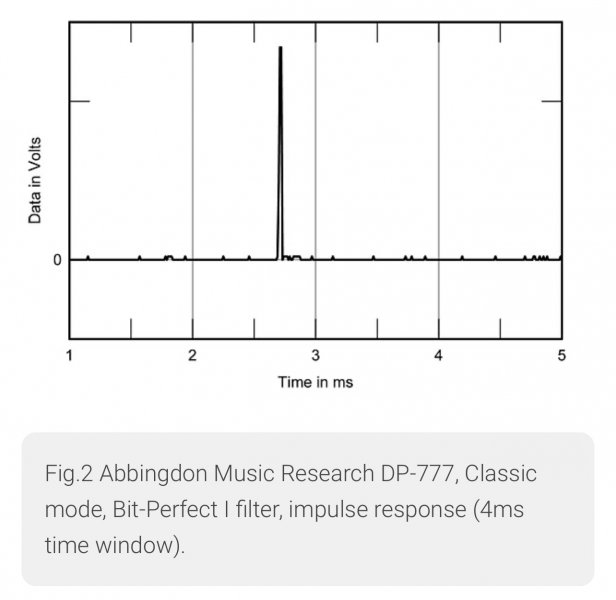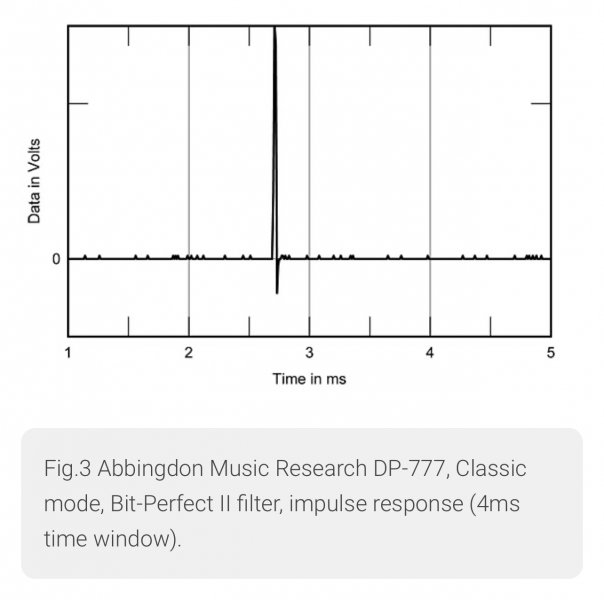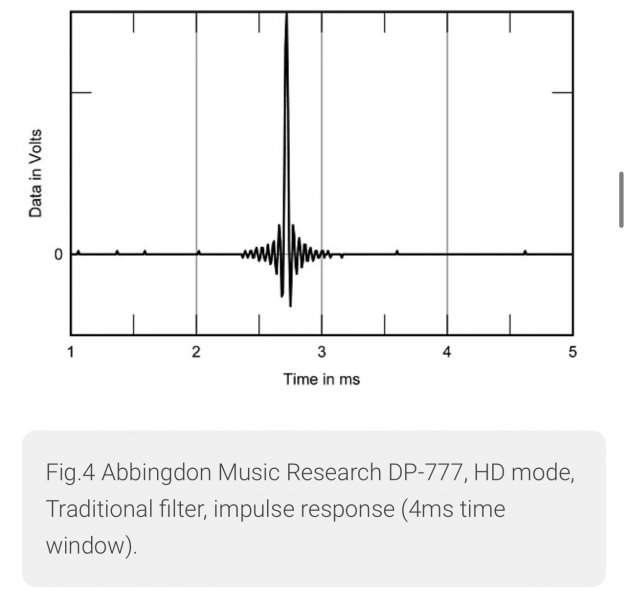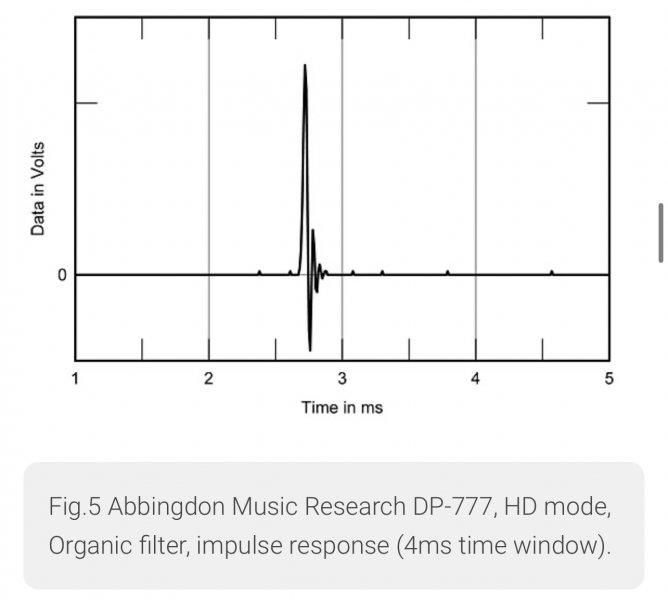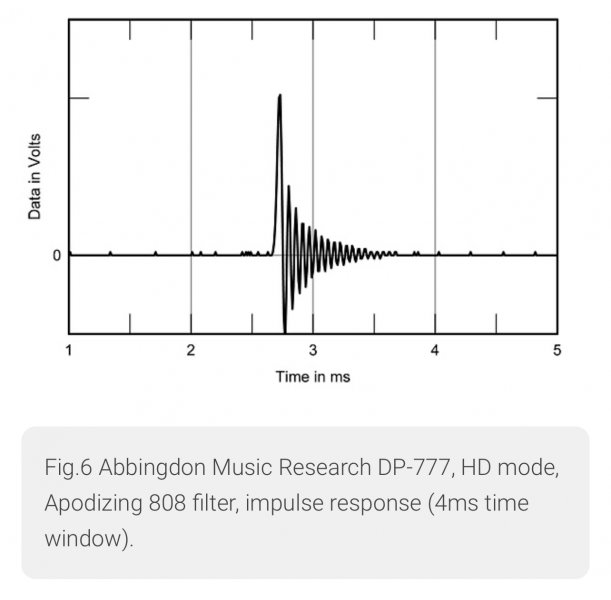a good way for comparing effects of different filters is listening to AMR DAC with different filters :
Most vinyl-sounding DAC?
- Thread starter asegal
- Start date
You are using an out of date browser. It may not display this or other websites correctly.
You should upgrade or use an alternative browser.
You should upgrade or use an alternative browser.
I had AMR DAC and listened to it’s sound with different filters.
I think for judging the effects of different filters we should consider the music type (instrument type) and the speaker tweeter plus speaker crossover.
I think for judging the effects of different filters we should consider the music type (instrument type) and the speaker tweeter plus speaker crossover.
How good is that DAC?I had AMR DAC and listened to it’s sound with different filters.
I think for judging the effects of different filters we should consider the music type (instrument type) and the speaker tweeter plus speaker crossover.
In a tube system It was good in it’s price range.How good is that DAC?
This whole thread is pointless when you consider that Vinyl transfer is mastered and/or prepped differently from digital.
I have tried numerous LP's that had digital versions and it is clear that the mastering is very different and nobody is talking about that. Something to try or consider the what Mark Levinson is now doing with a remastering tool for his Daniel Hertz line. I have dabbled a bit with remastering versions of digital releases to emulate the sound of vinyl and found that there is significant processing and inherent characteristics that vinyl exhibits. Also noteworthy is that the sonic impact of issues with vinyl rigs are very different than those of digital.
The question therefore should be is are vinyl releases from digital masters better than their digital releases? They technically can not be, they can only be different and the extra mastering is something to look into.
I have tried numerous LP's that had digital versions and it is clear that the mastering is very different and nobody is talking about that. Something to try or consider the what Mark Levinson is now doing with a remastering tool for his Daniel Hertz line. I have dabbled a bit with remastering versions of digital releases to emulate the sound of vinyl and found that there is significant processing and inherent characteristics that vinyl exhibits. Also noteworthy is that the sonic impact of issues with vinyl rigs are very different than those of digital.
The question therefore should be is are vinyl releases from digital masters better than their digital releases? They technically can not be, they can only be different and the extra mastering is something to look into.
I’d agree for sure. Digital done really well can be great… and it has its own advantages but in the end analogue as in a complete whole analogue as an exemplary top end process at the best levels (to borrow a great phrase from Mike Lavigne) seems just more complete. The better spectrum of each never really sounds the same fundamentally to me at any rate while they both can approach greatness they come at it as different kinds of material fabrics… just the way solid state and tubes still come to me as being fundamentally characteristically different within themselves.The closer digital appears to get to vinyl, the more the positives of analog outpace it. Certainly that's my experience on multiple listens to the most highly regarded digital source currently being touted.
My advice? Forget trying to get digital to emulate, or match vinyl. Just get digital that sounds immersive and non fatiguing in its own right.
Even in the videos done at Mike’s place recently by Thomas the sound of the digital in the video still came across to me as different from the analogue presentation and it may have demonstrated an embodiment of wholeness that Mike had pointed to in his system and which seemed to kind of escape the presentation of the digital… all of which I’m sure still would have managed to be really engaging and musically and sonically very impressive in its own way in real life… but still just not seeming the same.
Of course dCS measures superb, because it employs sharp filter and/or oversampling which offers best measurement performance with good frequency response characteristics. On the other hand very slow filters (or NOS) keep linear phase and offer great transient characteristics which is more important than frequency response for people (including me) in terms of SQ.Based on what evidence?
And with respect to the impulse response graphs, what exactly is missing versus other options? If you read all the way through the technical analysis, John Atkinson concludes the technical review as follows:
"Like its Vivaldi predecessor and the Rossini Apex, the dCS Vivaldi Apex features superb measured performance.—John Atkinson"
Last edited:
+1Of course dCS measures superb, because it employs sharp filter and/or oversampling which offers best measurement performance with good frequency response characteristics. On the other hand very slow filters (or NOS) keep linear phase and offer great transient characteristics which is more important than frequency response for people (including me) in terms of SQ.
slow filter make the best responce square wave with 24 bit /96 khz extand bandwidth. You can see in my link
Please consider some parameters are important for judging the sound of dCS DACs.
I recommend you to listen to dCS DACs in more phase linear crossovers and softer/smoother tweeters like Wilson Alexandria.
In my experience in some complex music types the dCS performance was good when the speaker was Wilson Alexandria.
I have listened to two different DACs (dCS vs NOS) for many hours side by side and I think it is not easy to say dCS is not good.
I agree NOS dacs are more natural but those NOS DACs are not perfect in all area.
I recommend you to listen to dCS DACs in more phase linear crossovers and softer/smoother tweeters like Wilson Alexandria.
In my experience in some complex music types the dCS performance was good when the speaker was Wilson Alexandria.
I have listened to two different DACs (dCS vs NOS) for many hours side by side and I think it is not easy to say dCS is not good.
I agree NOS dacs are more natural but those NOS DACs are not perfect in all area.
Accuphase from japan chooses this name for showing importance of time response.
Accuphase = Accurate + Phase
Accuphase = Accurate + Phase
They have build amazing machines 16 dacs chips to get best low level resolution the dc 91 dac is today under the top 3 dacs for me when you hear only cd.Accuphase from japan chooses this name for showing importance of time response.
Accuphase = Accurate + Phase
I have listened to accuphase 90/91 in tehran. It’s was the golden age of accuphase they produced 90/91 and also A100 class A power amplifier.
In Iran we never seen any failure/problem in Accuphase systems but there was many problems in krell, mark levinson … systems.
I always like the quality of Accuphase . Japan culture is different
In Iran we never seen any failure/problem in Accuphase systems but there was many problems in krell, mark levinson … systems.
I always like the quality of Accuphase . Japan culture is different
Be sure to try the recommended minimum phase filters playing back music with a dCS DAC (as well as note that the Upsampler can be set to "PassThru" or "Native" depending on the generation, allowing for a virtual plethora of choices and near-endless comparisons - for audiophiles who are so inclined…). The factory settings (fast symmetrical filters) are for repair (measurement) purposes (explicitly noted, in earlier generation manuals, not for listening). I've wondered, since there are so many filter settings, especially with Upsampler and DAC combined, that dCS had to update the manuals with recommendations (those paragraphs titled “I don’t have time to listen to all these filters! Which ones do you suggest?”), why they couldn't just add a recommended filter settings button/icon along with the factory setting (that one's favorite settings can be saved is a plus, but one needs to manually set them for each and every sampling rate, not to mention PCM and DSD). I understand that the wide range of choice these units provide today is the result of a long history of updates, but I've always had my doubts that audiophiles are patient enough to go through all the options, and although the manuals list all the filter types, it's not intuitive as to which sound best (not the fast symmetrical ones that measure "best", obviously - although I'd like to add that those do not in fact measure best in terms of impulse and phase response, but e.g. bandwidth). Besides, some people do not read manuals, e.g. engineers in my experience are infamous for ignoring them, as are audiophiles, which sadly proves a point I've been trying to make for years, LOL!Of course dCS measures superb, because it employs sharp filter and/or oversampling which offers best measurement performance with good frequency response characteristics. On the other hand very slow filters (or NOS) keep linear phase and offer great transient characteristics which is more important than frequency response for people (including me) in terms of SQ.
Greetings from Switzerland, David.
Last edited:
Thanks for the information but my intention was not to argue if dCS sounds good or bad. I just wanted to point out that a sharp filter measures well but doesn’t necessarily sound good. Filter choices depend on personal preferences and I prefer NOS or very slow filter over sharp. IMHO if you’re after most vinyl sounding DAC, oversampling or sharp filter is the opposite way to go due to pre and post ringing artifacts.Be sure to try the recommended minimum phase filters playing back music with a dCS DAC (as well as note that the Upsampler can be set to "PassThru" or "Native" depending on the generation, allowing for a virtual plethora of choices and near-endless comparisons - for audiophiles who are so inclined…). The factory settings (fast symmetrical filters) are for repair (measurement) purposes (explicitly noted, in earlier generation manuals, not for listening). I've wondered, since there are so many filter settings, especially with Upsampler and DAC combined, that dCS had to update the manuals with recommendations (those paragraphs titled “I don’t have time to listen to all these filters! Which ones do you suggest?”), why they couldn't just add a recommended filter settings button/icon along with the factory setting (that one's favorite settings can be saved is a plus, but one needs to manually set them for each and every sampling rate, not to mention PCM and DSD). I understand that the wide range of choice these units provide today is the result of a long history of updates, but I've always had my doubts that audiophiles are patient enough to go through all the options, and although the manuals list all the filter types, it's not intuitive as to which sound best (not the fast symmetrical ones that measure "best", obviously - although I'd like to add that those do not in fact measure best in terms of impulse and phase response, but e.g. bandwidth).
Greetings from Switzerland, David.
Nor was it my intention to argue if dCS sounds good or bad, merely that there’s choice, and that one shouldn’t limit oneself to listening with the factory settings (those filters mentioned above that are really only there for measurements/servicing purposes). Besides, the most “vinyl sounding” DAC is a neutral DAC playing back a rip from vinyl. I heard master tapes played back from reel-to-reel recorder direct and through ADC/DAC, switching back and forth in a single blind comparison, and despite what golden ears one might pride oneself in having, no one was able to detect which was which (one of those situations much like wine tastings where in hindsight, everyone swears they knew all along, blabla…).Thanks for the information but my intention was not to argue if dCS sounds good or bad. I just wanted to point out that a sharp filter measures well but doesn’t necessarily sound good. Filter choices depend on personal preferences and I prefer NOS or very slow filter over sharp. IMHO if you’re after most vinyl sounding DAC, oversampling or sharp filter is the opposite way to go due to pre and post ringing artifacts.
Greetings from Switzerland, David.
Unfortunately it is remotely related with ears or audiophile ability on sound comparisons. If there is no noticeable difference between direct from R2R tape and R2R to ADC to DAC then it only proves the equipment (amps, cables, preamps, speakers etc) used is not up to the task. Better equipment is needed. Any additional component or process is audible. It has always been like this. That's the common mistake that pro people fall into.I heard master tapes played back from reel-to-reel recorder direct and through ADC/DAC, switching back and forth in a single blind comparison, and despite what golden ears one might pride oneself in having, no one was able to detect which was which (one of those situations much like wine tastings where in hindsight, everyone swears they knew all along, blabla…).
There’s always room to upgrade, but the system was by no means bad (nor, in fact, a studio system), on the contrary. I was younger back then, and it was so tough a sizable wager would have been out of the question. Besides, the nerds from the manufacturer were able to tell the difference - but not because of something the average person would deem musically relevant (the tape noise). Anyway, my point was and is, if you want a DAC that sounds like vinyl playback rather than live music, digitize vinyl and play those files back on a transparent DAC - there’s no way of getting closer to that goal. Vinyl playback has a more “unifying” (its own - that’s why Michael Fremer digitizes samples for comparison with later review samples) character depending on the turntable, arm, cartridge, pre and cables, that I don’t think is any digital designer’s objective in a DAC. I like both for what they are, and would only want them to sound alike if they sounded like the real thing. At this point in their technological evolution, I still hear a somewhat more pleasurable versus less colored dichotomy (I’ve yet to hear perfection).Unfortunately it is remotely related with ears or audiophile ability on sound comparisons. If there is no noticeable difference between direct from R2R tape and R2R to ADC to DAC then it only proves the equipment (amps, cables, preamps, speakers etc) used is not up to the task. Better equipment is needed. Any additional component or process is audible. It has always been like this. That's the common mistake that pro people fall into.
Greetings from Switzerland, David.
I changed the factory settings to those recommended by John Giolas. Then local dealer Scott Carpenter who has excellent critical listening skills created his own settings based on lengthy listening sessions and shared them with me. I really have found them to be superb.Be sure to try the recommended minimum phase filters playing back music with a dCS DAC (as well as note that the Upsampler can be set to "PassThru" or "Native" depending on the generation, allowing for a virtual plethora of choices and near-endless comparisons - for audiophiles who are so inclined…). The factory settings (fast symmetrical filters) are for repair (measurement) purposes (explicitly noted, in earlier generation manuals, not for listening). I've wondered, since there are so many filter settings, especially with Upsampler and DAC combined, that dCS had to update the manuals with recommendations (those paragraphs titled “I don’t have time to listen to all these filters! Which ones do you suggest?”), why they couldn't just add a recommended filter settings button/icon along with the factory setting (that one's favorite settings can be saved is a plus, but one needs to manually set them for each and every sampling rate, not to mention PCM and DSD). I understand that the wide range of choice these units provide today is the result of a long history of updates, but I've always had my doubts that audiophiles are patient enough to go through all the options, and although the manuals list all the filter types, it's not intuitive as to which sound best (not the fast symmetrical ones that measure "best", obviously - although I'd like to add that those do not in fact measure best in terms of impulse and phase response, but e.g. bandwidth). Besides, some people do not read manuals, e.g. engineers in my experience are infamous for ignoring them, as are audiophiles, which sadly proves a point I've been trying to make for years, LOL!
Greetings from Switzerland, David.
Last edited:
Similar threads
- Replies
- 38
- Views
- 5K
- Sticky
- Replies
- 23
- Views
- 2K
- Replies
- 101
- Views
- 16K
- Replies
- 108
- Views
- 25K
Members online
- Aries Cerat
- hesavary
- rau
- spearl8
- Myles1972
- Zarir
- jbazz
- Miramunt
- Nsxturbo
- Walnut Horns
- Opabin
- Carlsbad
- jaxdr
- jeromelang
- bryans
- Dvuc
- JRW1971
- asb
- dminches
- the sound of Tao
- ecwl
- Corinthian
- Dierkx1
- Jazzman53
- gfroman
- Charlie B.
- marty
- George_ts
- hopkins
- MacF
- Kingrex
- andromedaaudio
- typalder
- morricab
- AudioHR
- ton77
- luca.pelliccioli
- worldtime
- Bonesy Jonesy
- bonzo75
- Salectric
- miniguy
- Nathanu
- kswanson27
- AlbertD
- TooCool4
- agencal
- Husk
- Three quid
- R S
Total: 1,525 (members: 88, guests: 1,437)
| Steve Williams Site Founder | Site Owner | Administrator | Ron Resnick Site Co-Owner | Administrator | Julian (The Fixer) Website Build | Marketing Managersing |












